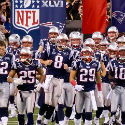Yes, the Patriots trounced the Rams Sunday night at the Super Bowl, but two competing network performance reports don't offer nearly that kind of clarity about which wireless network operator offered the fastest network at the event.

At the end of last night's Super Bowl game, it was clear that the Patriots trounced the Rams. However, it's not clear which wireless network operator provided the fastest speeds at Atlanta’s Mercedes-Benz Stadium, where the game was held.
That's because two different network testing companies -- Ookla and Tutela -- offer notably different takes on how the networks of AT&T, Verizon, T-Mobile and Sprint performed during the big game.
According to Tutela, Verizon provided the fastest average download speeds at the stadium during the game at around 38Mbps. AT&T came in second, Sprint in third and T-Mobile came in last place. But according to Ookla, T-Mobile provided the fastest mean download speeds at around 102Mbps, while Sprint came in second, Verizon came in third and AT&T came last.
What's happening here?
Ookla's data was obtained through its crowd-sourced Speedtest app, while Tutela's data comes from software in third-party applications that collects data in the background while users are using certain apps. Differences in results can also be due to a wide variety of other factors, including the geographic scope of each company's tests, the phones people used during those tests, how much data each firm collected and how they analyzed that data.
Moreover, this isn't the first time that network-testing companies have drawn significantly different conclusions from the same event. As noted by BGR, the exact same thing happened at last year's Super Bowl.
And this is why just about every wireless operator currently claims that it operates the best, fastest or most reliable network; it's because each operator can point to a survey, test or report that backs up their claim. Indeed, T-Mobile wasted no time trumpeting Ookla's results from yesterday's game. (See Verizon, Using AT&T's 5G Definition, Stakes a Bold Coverage Claim.)
Perhaps the one takeaway from the initial findings from Ookla and Tutela from this year's Super Bowl is that almost all of the nation's wireless network operators were able to provide speeds close to or in excess of the FCC's 25Mbps threshold for broadband services -- and that's without 5G. It's an impressive performance for LTE in general, considering the Super Bowl invariably creates the kind of data-hungry crowds that can easily overwhelm a wireless network with finite spectrum resources. (See FCC Sets 25/3 as New Broadband Bar.)
You're invited to attend Light Reading’s Big 5G Event! Formerly the Big Communications Event and 5G North America, Big 5G is where telecom's brightest minds deliver the critical insight needed to piece together the 5G puzzle. We'll see you May 6-8 in Denver -- communications service providers get in free!
Of course, that's probably partly because the Super Bowl also stands as an event that wireless network operators can plan for -- and each of the nation's wireless operators certainly did that. AT&T, for example, upgraded its Distributed Antenna System at the stadium, and added new small cells. Similarly, Sprint rolled out Massive MIMO antennas in Atlanta. T-Mobile and Verizon engaged in similar work (perhaps the most interesting takeaway from all this is that Verizon routed most of their customers through its own Wi-Fi network at the stadium, according to Ookla, where the firm recorded an average download speed of around 46Mbps).
The advertising game
Network speeds weren't necessarily the top focus for some of the nation's wireless network operators. After all, the event continues to bring in huge viewership numbers and stands annually as a major advertising platform for the companies that can afford the reported $5 million for a 30-second TV spot.
Verizon apparently wasn't scared off by that price tag though as the operator spent an estimated $30 million, according to ad-tracking company iSpot, to promote its offerings for public-safety users (likely a response to AT&T's FirstNet-powered public-safety initiative, as well as its public black-eye from throttling firefighters last year). T-Mobile, meantime, spent an estimated $20 million to tell its customers they could get a free Lyft ride and Taco as part of its ongoing T-Mobile Tuesdays customer-loyalty program.
And Sprint spent an estimated $5.9 million to reiterate its network and its pricing plans.
(It's also worth noting that a relatively new MVNO in the US market, Mint Mobile, spent a whopping $5.3 million to tell customers they can get three months of wireless service for $20, for all three months.)
AT&T sat out the advertising game.
— Mike Dano, Editorial Director, 5G & Mobile Strategies, Light Reading | @mikeddano
About the Author(s)
You May Also Like










